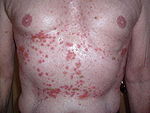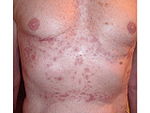
Grover's disease
Encyclopedia
Grover's disease is a polymorphic, pruritic, papulovesicular dermatosis characterized histologically by acantholysis
.

 Grover's disease often starts quite suddenly. It results in very itchy spots on the central back, mid chest and occasionally elsewhere. Frequently, it follows sweating or some unexpected heat stress.
Grover's disease often starts quite suddenly. It results in very itchy spots on the central back, mid chest and occasionally elsewhere. Frequently, it follows sweating or some unexpected heat stress.
Symptoms of Grover's disease are characterized by an itchy eruption that may last an average of 10–12 months. It is characterized by papules and papulovesicles with excoriations occurring on the chest, back, lower sternum, arms, and thighs. Grover's Disease is mainly seen in males over the age of forty and the papules are most commonly found on the mid chest.
Sometimes the features of Grover's are found in people who do not itch or have a conspicuous rash. Most of the people with Grover's who visit a dermatologist, however, itch a lot. Grover's disease (GD), or transient acantholytic dermatosis, is a pruritic, papulovesicular eruption characterized histopathologically by acantholysis with or without dyskeratosis.
It is thought that Grover's disease affects chiefly white adults in the fifth decade or later, and appears to be around 1.6 to 2.1 times more common in men than in women. Grover's disease appears less commonly in darker-skinned individuals, but has been reported.
Some cases of Grover's disease have been associated with medications such as sulfadoxine-pyrimethamine, ribavirin, cetuximab, and interleukin-4 [1,8-15]. One series of 300 patients with Grover's disease reported an association with other coexisting dermatoses including atopic dermatitis, contact dermatitis, and xerosis cutis. Finally, smaller series have detailed an association with pyoderma gangrenosum, bacterial and viral infections, and occasionally, malignancies.
or tetracycline. If these fail or the outbreak is severe, PUVA phototherapy treatments, antifungal pills and cortisone injections are alternatives.
A further treatment option is a cream of zinc oxide, talc, and glycerol. This cream helps with the itching and promotes faster healing. In France, where it is available over the counter (OTC), the zinc oxide, talc, and glycerol cream is branded as Aloplastine.
Sometimes, Grover's disease can be complicated by the development of dermatitis. (Non sequitur mixing cause with complications) Although the cause of Grover's is unknown, it may arise in quite dry skin. Many affected individuals are sun damaged.
Some research has correlated damage to the basement membrane and mercury toxicity with Grover's disease. Damage to the basement membrane might be from sun damage, age, or other factors. Mercury in the body causes the cellular reaction that we know as Grover's disease. The recommended treatment explained in this article is with Chemet
. After treatment, subsequent flaring may be caused by the release of mercury stored deeper in the body or from mercury that comes into the body from our environment. Both require the patient to be vigilant about maintaining an internal environment that is as free as possible from mercury.
Acantholysis
Acantholysis is the loss of intercellular connections, such as desmosomes, resulting in loss of cohesion between keratinocytes, seen in diseases such as pemphigus vulgaris. It is absent in bullous pemphigoid, making it useful for differential diagnosis....
.
Symptoms


Symptoms of Grover's disease are characterized by an itchy eruption that may last an average of 10–12 months. It is characterized by papules and papulovesicles with excoriations occurring on the chest, back, lower sternum, arms, and thighs. Grover's Disease is mainly seen in males over the age of forty and the papules are most commonly found on the mid chest.
Sometimes the features of Grover's are found in people who do not itch or have a conspicuous rash. Most of the people with Grover's who visit a dermatologist, however, itch a lot. Grover's disease (GD), or transient acantholytic dermatosis, is a pruritic, papulovesicular eruption characterized histopathologically by acantholysis with or without dyskeratosis.
Epidemiology
The prevalence and incidence of Grover's disease have not been firmly established. In a study from Switzerland, Grover's disease was diagnosed in just 24 of more than 30,000 skin biopsies [4].It is thought that Grover's disease affects chiefly white adults in the fifth decade or later, and appears to be around 1.6 to 2.1 times more common in men than in women. Grover's disease appears less commonly in darker-skinned individuals, but has been reported.
Etiology
The etiology of Grover's disease is unknown. Suspected triggers of disease activity include heat and sweating, sunlight, ionizing irradiation, end-stage renal disease/hemodialysis, and mechanical irritation or prolonged bed rest.Some cases of Grover's disease have been associated with medications such as sulfadoxine-pyrimethamine, ribavirin, cetuximab, and interleukin-4 [1,8-15]. One series of 300 patients with Grover's disease reported an association with other coexisting dermatoses including atopic dermatitis, contact dermatitis, and xerosis cutis. Finally, smaller series have detailed an association with pyoderma gangrenosum, bacterial and viral infections, and occasionally, malignancies.
Diagnosis
Grover's may be suspected by its appearance, but since it has such a characteristic appearance under the microscope a shave skin or punch biopsy is often performed. Once confirmed, most cases of Grover's disease last six to twelve months (which is why it was originally called "transient"). Unfortunately it may last much longer.Treatment
The most important thing about Grover's disease treatment is to remain cool, as further sweating will induce more itchy spots. However, lesions aggravated by sweat usually return to "normal" fairly quicklyavoiding sweat is not a reason to avoid exercise. Minor outbreaks can be controlled with prescription strength topical cortisone creams. More troubling eruptions usually clear up after treatment for one to three months with AccutaneIsotretinoin
Isotretinoin, INN, is a medication used mostly for cystic acne. It was first developed for brain, pancreatic and other cancers. It is used to treat harlequin-type ichthyosis, a usually lethal skin disease, and lamellar ichthyosis. Its effects are systemic and nonselective...
or tetracycline. If these fail or the outbreak is severe, PUVA phototherapy treatments, antifungal pills and cortisone injections are alternatives.
A further treatment option is a cream of zinc oxide, talc, and glycerol. This cream helps with the itching and promotes faster healing. In France, where it is available over the counter (OTC), the zinc oxide, talc, and glycerol cream is branded as Aloplastine.
Sometimes, Grover's disease can be complicated by the development of dermatitis. (Non sequitur mixing cause with complications) Although the cause of Grover's is unknown, it may arise in quite dry skin. Many affected individuals are sun damaged.
Some research has correlated damage to the basement membrane and mercury toxicity with Grover's disease. Damage to the basement membrane might be from sun damage, age, or other factors. Mercury in the body causes the cellular reaction that we know as Grover's disease. The recommended treatment explained in this article is with Chemet
Dimercaptosuccinic acid
Dimercaptosuccinic acid , is the organosulfur compound with the formula HO2CCHCHCO2H. This colorless solid contains two carboxylic acid and two thiol groups, the latter being responsible for its mildly unpleasant odour. It occurs in two diastereomers, meso and the chiral dl forms...
. After treatment, subsequent flaring may be caused by the release of mercury stored deeper in the body or from mercury that comes into the body from our environment. Both require the patient to be vigilant about maintaining an internal environment that is as free as possible from mercury.
External links
- Pruritic Papules on the Chest and Back. American Family PhysicianAmerican Family PhysicianAmerican Family Physician is a semimonthly, peer-reviewed medical journal of the American Academy of Family Physicians. AFP’s chief objective is to provide high-quality continuing medical education for more than 190,000 family physicians and other primary care clinicians...
. August 15, 2006.

